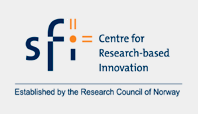Disclaimer
The data, information, and resources, applications, and electronic services on this web site (further called LiceBase) is provided to you by the Sea Lice Research Centre (SLRC) free of charge on a BEST EFFORT basis for the sole purpose of research. There is no warranty for correctness of data and information in LiceBase neither expressed or implied; there is no warranty for the fitness of data, and applications in LiceBase for any particular purpose, including merchantability or commercial application. The owner of LiceBase DISCLAIMS any liability for material or immaterial losses incured by using LiceBase or one of the resources or data provided by this site.
Data usage policy
The data, information, resources, and services available through this site are owned by the Sea Lice Research Centre and the University of Bergen Norway. The owner of the data and services grants you a non-exclusive, non-transferable, revocable license to use the data and services provided for the purpose of research. Fair usage policy applies. Note that the owner of the data intends to publish the genome assembly, genome annotation, including but not limited to protein coding genes, gene expression, non-coding RNAs, repetitive sequences, and conserved regions.
Funding and Organization
 LiceBase is a database for sea lice genomics. LiceBase provides the genome annotation of the Atlantic salmon louse Lepeophtheirus salmonis, a genome browser, Blast functionality and access to related high-thoughput genomics data.
LiceBase is a database for sea lice genomics. LiceBase provides the genome annotation of the Atlantic salmon louse Lepeophtheirus salmonis, a genome browser, Blast functionality and access to related high-thoughput genomics data.LiceBase - defined as work package 5 of the SLRC - is a system for storing and mining the data from within this and related projects and is aimed to be the preferred site for the global research community for access to genome data on sea lice and other related genomes. The work will involve both development and application of bioinformatics tools to facilitate data representation and analysis (e.g., genome annotation, integration of data from genome-wide functional studies).
 LiceBase is also an international deliverable in work package 3 of the Norwegian Elixir node. ELIXIR Norway is coordinated by the University of Bergen and includes the University of Oslo, the University of Tromsø, the Norwegian University of Science and Technology in Trondheim, and the Norwegian University of Life Sciences at Ås. The Research Council of Norway supports the Node primarily through its program for research infrastructure. LiceBase is integrated with NELS, the Norwegian e-infrastructure for life sciences, which contains several integrated packages geared towards genome scale analyses, provision of web services, and genomics toolboxes.
LiceBase is also an international deliverable in work package 3 of the Norwegian Elixir node. ELIXIR Norway is coordinated by the University of Bergen and includes the University of Oslo, the University of Tromsø, the Norwegian University of Science and Technology in Trondheim, and the Norwegian University of Life Sciences at Ås. The Research Council of Norway supports the Node primarily through its program for research infrastructure. LiceBase is integrated with NELS, the Norwegian e-infrastructure for life sciences, which contains several integrated packages geared towards genome scale analyses, provision of web services, and genomics toolboxes.
People
- Project leader LiceBase development: Michael Dondrup (admin@licebase.org), Researcher at SLRC and the Department of Informatics, UiB
- Scientific programmer: Wei Zhang
- Work package leader (SLRC WP5, Node leader Elixir Norway): Inge Jonassen, Professor at Department of Informatics, UiB
Legal
By using the site with or without authentication you agree to our Privacy Policy and our Terms and Conditions.
Software
 For sustainability, we are following a free-open-source software policy for use of software to build LiceBase. We are relying on excellent pieces of software developed by the Generic Model Organism Database project (GMOD) and other open source projects. We are very grateful for the contributions from countless individuals to free-open-source software we are using, and we are also publishing our modifications to components, if applicable.
For sustainability, we are following a free-open-source software policy for use of software to build LiceBase. We are relying on excellent pieces of software developed by the Generic Model Organism Database project (GMOD) and other open source projects. We are very grateful for the contributions from countless individuals to free-open-source software we are using, and we are also publishing our modifications to components, if applicable.
LiceBase is built using Tripal and Drupal. We are using GBrowse as the Genome browser, we have implemented some modifications to allow using SAML-IdP based authentication for single-signon (SSO) between Drupal/Tripal and GBrowse.


SimpleSAMLphp is developed by UniNet and used for authetication and SSO.

For running Blast, we provide an enhanced version of the GBrowse tool BLAST Graphic Viewer.
The source code of adapted components is available here:
- Our GBrowse fork ist available on Github
- Our version of Blast Viewer is on Github
- Our fork of Tripal 1.1 which allows for editing of feature properties and coordinates on Github
- CVautocomplete, our fork of the autocomplete CCK widget module, which allows to use a Chado controlled vocabulary for autocompletion fields
Mission Statement
“One of our objectives is to promote the development of more effective, less harmful medicines to combat sea lice,” explains Sigmund Grønmo, Rector of UiB and the proud host of the SLRC.
